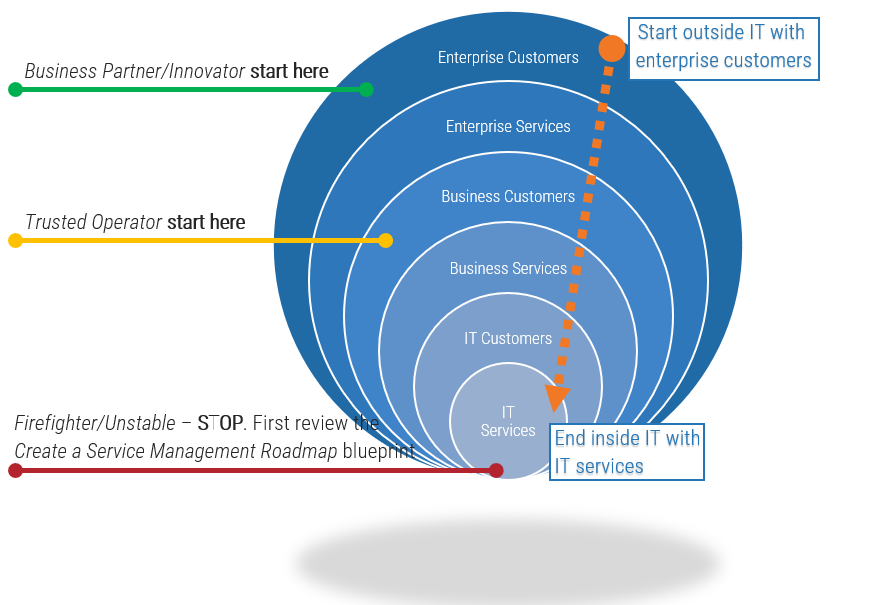When identifying IT services, many IT leaders skip the critical first step of understanding their enterprise services and customers. IT leaders often:
- Fail to see the connection between enterprise customers and IT customers.
- Think operationally and therefore see services either as “customer services” or confuse them with applications, systems, and technology.
- Rely on tools to define what IT offers.
- Fail to recognize the role of culture and transformation in creating and sustaining aligned IT services.
Our Advice
Critical Insight
- Abandon the traditional approach of cataloging all that IT has to offer and deploying these offerings to the organization as needs arise.
- For optimal value delivery, shift your perspective away from IT and toward the needs of the enterprise customer. This method not only ensures accurate business service alignment and high-value service delivery, but also secures IT’s place in the organization as a trusted business advisor.
Impact and Result
- Take the essential first step most IT organizations miss and define your IT services from the outside in:
- Replace nebulous concepts of services with a coherent definition.
- Enable services through a customer-focused culture.
- Craft an aspirational service vision and use it as you identify and document your enterprise-aligned IT services.
- Chronicle your IT services, along with the value they provide, to your executives.
Workshop: Define Your Enterprise IT and Digital Services
Workshops offer an easy way to accelerate your project. If you are unable to do the project yourself, and a Guided Implementation isn't enough, we offer low-cost delivery of our project workshops. We take you through every phase of your project and ensure that you have a roadmap in place to complete your project successfully.
Module 1: Understand Services, Customers, and Where to Start
The Purpose
- Level-set what a service and its related components are so that in the later activities, services are identified accurately.
- Introduce the importance of culture for enabling and supporting services.
- Assess areas of focus for a service enabling/supporting culture in the organization.
Key Benefits Achieved
- Understand what a service is to build on when identifying IT services in later activities.
- Identified elements of culture to ensure the ongoing success of IT services.
Activities
Outputs
Consider example services.
- Documented reason for why each example is a service
Determine where to start based on maturity level.
- Estimated maturity level to use to determine which customer to target
Complete a cultural readiness assessment.
- Completed cultural readiness assessment
Module 2: Prioritize Cultural Areas of Focus and Identify Business Customers and Services, and IT Services
The Purpose
- Determine which areas of focus are most important to address in the cultural assessment.
- Introduce identifying enterprise customers and services using the value stream in their own capability map.
Key Benefits Achieved
- Understand what they would like to focus on for culture change and when they’d like to focus on these things in a high-level timeline (now, next, later).
- Apply concepts of service, customer, value, and value chain learned previously to their own environment to begin understanding the enterprise customer and services. This sets the foundation for accurate IT service alignment completed in later exercises.
Activities
Outputs
Prioritize areas to address and enter into timeline.
- Prioritized list of areas to focus on to transform culture to best support IT services
Use value stream map to identify business customers.
- Business customers identified and aligned to value stream
Use value stream map to identify business services.
- Business services identified
Begin to identify IT services.
- Initial IT services identified and aligned to business services and customers
Module 3: Identify and Align IT Services
The Purpose
- Continue to identify and align IT services to business services and customers.
Key Benefits Achieved
- Identified IT services aligned to business services
Activities
Outputs
Continue to identify and align IT services.
- IT services aligned to business services and customers
Module 4: Identify and Align IT Services to Business Services and Goals and Complete Executive Presentation
The Purpose
Key Benefits Achieved
Activities
Outputs
Finish identifying and aligning IT services.
- Draft service map with reviewed and finalized services aligned to business services, customers, and business goals
Define IT services and align to goals.
- List of services with service definitions, owners, and aligned goals identified
Review services.
- Finalized service map and list of services
Complete executive presentation.
- Completed executive presentation
Craft message and practice delivering executive presentation.
- Crafted communication for delivering executive presentation
Module 5: Next Steps and Wrap-Up (Offsite)
The Purpose
- Finalize work outstanding from previous steps and answer any questions.
Key Benefits Achieved
- Participants have thought about and documented how to customize the Info-Tech IT dashboards to use in their organization and have everything they need to customize the dashboards with their own metrics and visuals (if necessary).
Activities
Outputs
Complete in-progress deliverables from previous four days.
- Completed list of IT services with descriptions, owners, and strategic goal alignment
Set up review time for workshop deliverables and to discuss next steps.
- IT strategy roadmap




 Create a Service Management and IT Operations Strategy
Create a Service Management and IT Operations Strategy
 Develop a Plan to Pilot Enterprise Service Management
Develop a Plan to Pilot Enterprise Service Management
 Create a Service Management Roadmap
Create a Service Management Roadmap
 Elevate Your Service Capabilities to Drive Enterprise Value
Elevate Your Service Capabilities to Drive Enterprise Value
 Design and Build a User-Facing Service Catalog
Design and Build a User-Facing Service Catalog
 Create an IT View of the Service Catalog
Create an IT View of the Service Catalog
 Initiate Your Service Management Program
Initiate Your Service Management Program
 Develop Meaningful Service Metrics
Develop Meaningful Service Metrics
 IT Service Management Selection Guide
IT Service Management Selection Guide
 Service Management Integration With Agile Practices
Service Management Integration With Agile Practices
 Define Your Enterprise IT and Digital Services
Define Your Enterprise IT and Digital Services




